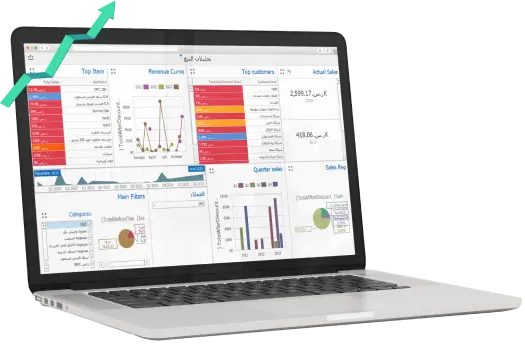The company's inventory carrying costs vary from company to company of each type of inventory and is based on the nature of the raw material if the inventory is raw materials or a finished product, and this varies from one industry to another, and according to the material quality and according to its nature is explosive, for example, or there is no harm from its holding in the warehouses, is it easy to purchase it at any time? Is the nature of the product perishable whether medicine or food? Is can it held in the warehouses or not, and whether the prices of raw materials and products are fixed, change slightly, or change dramatically.
All these factors determine the percentage of inventory can be held for a subsequent period
Ending Finished Goods Inventory Budget is associated with the sales budget and also associated with the production budget in the industrial companies and the consequent determination of the quantity that must be produced
Of course, if a commercial company results in the quantity of the products that you must purchase to cover the month’s sales + inventory that must be held for the next period
Ending Finished Goods Inventory Budget into Practical Reality
Ending Finished Goods Inventory Budget at each quarter or it is possible easily to prepare it monthly, the same idea, and it creates easily in Excel or if the accounting software includes the budgeting system.
To explain it better, let's assume we have a product called NMX
As we have stated, the company's inventory carrying costs vary from company to company to use it in the beginning of the next period, for example, the purchase or production may be difficult in the beginning of the next period for any reason of the stoppage - the market instability, for example, - the production is stopped for the maintenance, for example, or any other reason, and orders must be supplied to customers, and therefore it holds the inventory at the beginning of each period, and the company's inventory carrying costs vary from company to company in each region separately and for each product also separately, or there is a standard percentage according to the policy of each company.
For example, the company's inventory carrying cost is 25% in the northern region at the end of the period, and it is estimated, for example, that the sales at the beginning of the next period, let it be 3 million pounds
Ending inventory in the first quarter = 25% * 3 million (it is the second-quarter sales) =
Ending inventory in the second quarter = 25% * third-quarter sales
Ending inventory in the third quarter = 25% * fourth-quarter sales
And the last quarter of this budget is that will also be a percentage of the first-quarter sales for the following year
It is preferable, of course, to calculate it also monthly, to tighten control and prevent any variances
As for the beginning finished goods inventory in each quarter is the ending finished inventory from the previous quarter
Of course, the inventory carrying costs vary from period to period according to the market downturn or market boom as well as according to the sales territories
The calculation of the beginning and ending finished goods inventory is important because will result in the production budget that must be produced from the finished product in each period as well as the quantity of needs of each raw material (direct materials budget)
Production Budget
The sales budget is the starting point in preparing the production budget for the company, meaning that if the required sales quantity is determined, and then based on this, the required quantities are determined and the Planned Production in Units is calculated, which is
= Expected Sales in Units + Planned Ending Inventory in Units − Beginning Inventory in Units
The production budget aims to use a structured basis for the production planning so that the company can have products in the required quantities and at the appropriate times in the sense that the quantities produced are within the limitations of sales forecasting in the same period so that there is no gap between the quantities produced and the expected sales in the same period, and the sales budget it is the basis of all budgets, the production budget is the basis for preparing the direct materials budget, purchases budget, direct labor budget, and manufacturing overhead budget, and it is also as a guide for the production management to adhere to the quantities required for production and also at the same time a standard for measuring its performance and the production budget is divided into budgets monthly, quarterly and semi-annual and annual according to the nature of the product, the industry conditions and the conditions of the company, and the production budget should be set monthly to follow up the periodic plan of production in short periods to find out any malfunctions or to treat any possible variances that occur and it is assumed that before preparing the budget production for, examining the technical aspects for the machines and equipment in all industrial departments and an assessment of their efficiency regularly and work to update these machines in a way that leads to improving the specifications of goods and finished products.
Basics of Preparing the Production Budget
1- It is necessary to know the technical specifications for each finished products that included in the sales budget, the quantity of each of them, and the distribution of those quantities over the periods during the budget, as well as the company inventory policy and the optimal size of each inventory that must be held from each commodity separately.
2- The productive capacity of the technical services centers, maintenance, electricity, and internal transport.
3- Availability of raw materials needed to produce the finished product, the sources of obtaining them, and the purchasing policies.
4- The skill level of the company's workers and their ability to produce efficiently.
Production Budget into Practical Reality
The production budget is prepared for each product separately according to the estimated sales for each finished product in each region and each period, taking into account the inventory carrying cost in each period and the formula is as follows
Planned Production in Units =
Expected Sales in Units + Planned Ending Inventory in Units − Beginning Inventory in Units
Beginning Inventory is the Ending Inventory during the previous period
Of course, the production budget is associated with the sales budget, and the ending finished goods inventory budget, and this can be done by using Excel or accounting software include the budgeting system.










